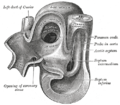Septum secundum
Septum secundum is an anatomical structure in the heart that plays a crucial role in the development of the heart's septal structure, which separates the right and left sides of the heart. This separation is essential for the proper direction of blood flow through the heart and the circulatory system. The septum secundum is part of the atrial septum, which divides the heart's atria, and its development and function are critical for normal heart physiology and embryonic heart development.
Development[edit]
The heart begins to develop early in embryonic life, with the septum secundum forming after the initial development of the Septum primum. As the septum primum grows towards the endocardial cushions, which eventually divides the atria from the ventricles, a second septal structure, the septum secundum, begins to form to the right of the septum primum. The septum secundum grows downward, partially overlapping the septum primum but leaving an opening known as the foramen ovale. This opening allows blood to flow directly from the right atrium to the left atrium, bypassing the fetal lungs, which are not yet in use as the fetus receives oxygenated blood from the placenta.
Function[edit]
During fetal development, the septum secundum's role is primarily in facilitating the correct flow of blood. The foramen ovale, bordered by the septum secundum, is a crucial component of fetal circulation. After birth, when the lungs expand and the infant begins to breathe air, the pressure changes in the heart lead to the closure of the foramen ovale. The septum primum and septum secundum press together, sealing the opening and thus separating the atria completely. This process completes the separation of the systemic and pulmonary circulations, which is essential for efficient oxygenation of blood in the lungs.
Clinical Significance[edit]
In some cases, the foramen ovale does not seal properly after birth, a condition known as a Patent foramen ovale. This condition can lead to a number of complications, including the potential for paradoxical emboli, where a blood clot passes from the right side of the heart to the left, bypassing the lungs and potentially causing a stroke. The septum secundum's development and the dynamics of its interaction with the septum primum are areas of interest in understanding congenital heart defects and their treatments.
Treatment and Management[edit]
The management of conditions related to the septum secundum, such as a patent foramen ovale, depends on the severity and the presence of symptoms or complications. In many cases, a patent foramen ovale may be left untreated if it is not causing significant problems. However, in cases where treatment is necessary, options may include medical management with anticoagulants to prevent clot formation or procedural interventions such as a percutaneous closure of the foramen ovale.
See Also[edit]
Septum_secundum[edit]
-
Septum primum and Septum secundum - early 7th week
-
Gray's Anatomy illustration 468
Ad. Transform your life with W8MD's Budget GLP-1 injections from $75


W8MD offers a medical weight loss program to lose weight in Philadelphia. Our physician-supervised medical weight loss provides:
- Weight loss injections in NYC (generic and brand names):
- Zepbound / Mounjaro, Wegovy / Ozempic, Saxenda
- Most insurances accepted or discounted self-pay rates. We will obtain insurance prior authorizations if needed.
- Generic GLP1 weight loss injections from $75 for the starting dose.
- Also offer prescription weight loss medications including Phentermine, Qsymia, Diethylpropion, Contrave etc.
NYC weight loss doctor appointmentsNYC weight loss doctor appointments
Start your NYC weight loss journey today at our NYC medical weight loss and Philadelphia medical weight loss clinics.
- Call 718-946-5500 to lose weight in NYC or for medical weight loss in Philadelphia 215-676-2334.
- Tags:NYC medical weight loss, Philadelphia lose weight Zepbound NYC, Budget GLP1 weight loss injections, Wegovy Philadelphia, Wegovy NYC, Philadelphia medical weight loss, Brookly weight loss and Wegovy NYC
|
WikiMD's Wellness Encyclopedia |
| Let Food Be Thy Medicine Medicine Thy Food - Hippocrates |
Medical Disclaimer: WikiMD is not a substitute for professional medical advice. The information on WikiMD is provided as an information resource only, may be incorrect, outdated or misleading, and is not to be used or relied on for any diagnostic or treatment purposes. Please consult your health care provider before making any healthcare decisions or for guidance about a specific medical condition. WikiMD expressly disclaims responsibility, and shall have no liability, for any damages, loss, injury, or liability whatsoever suffered as a result of your reliance on the information contained in this site. By visiting this site you agree to the foregoing terms and conditions, which may from time to time be changed or supplemented by WikiMD. If you do not agree to the foregoing terms and conditions, you should not enter or use this site. See full disclaimer.
Credits:Most images are courtesy of Wikimedia commons, and templates, categories Wikipedia, licensed under CC BY SA or similar.
Translate this page: - East Asian
中文,
日本,
한국어,
South Asian
हिन्दी,
தமிழ்,
తెలుగు,
Urdu,
ಕನ್ನಡ,
Southeast Asian
Indonesian,
Vietnamese,
Thai,
မြန်မာဘာသာ,
বাংলা
European
español,
Deutsch,
français,
Greek,
português do Brasil,
polski,
română,
русский,
Nederlands,
norsk,
svenska,
suomi,
Italian
Middle Eastern & African
عربى,
Turkish,
Persian,
Hebrew,
Afrikaans,
isiZulu,
Kiswahili,
Other
Bulgarian,
Hungarian,
Czech,
Swedish,
മലയാളം,
मराठी,
ਪੰਜਾਬੀ,
ગુજરાતી,
Portuguese,
Ukrainian


